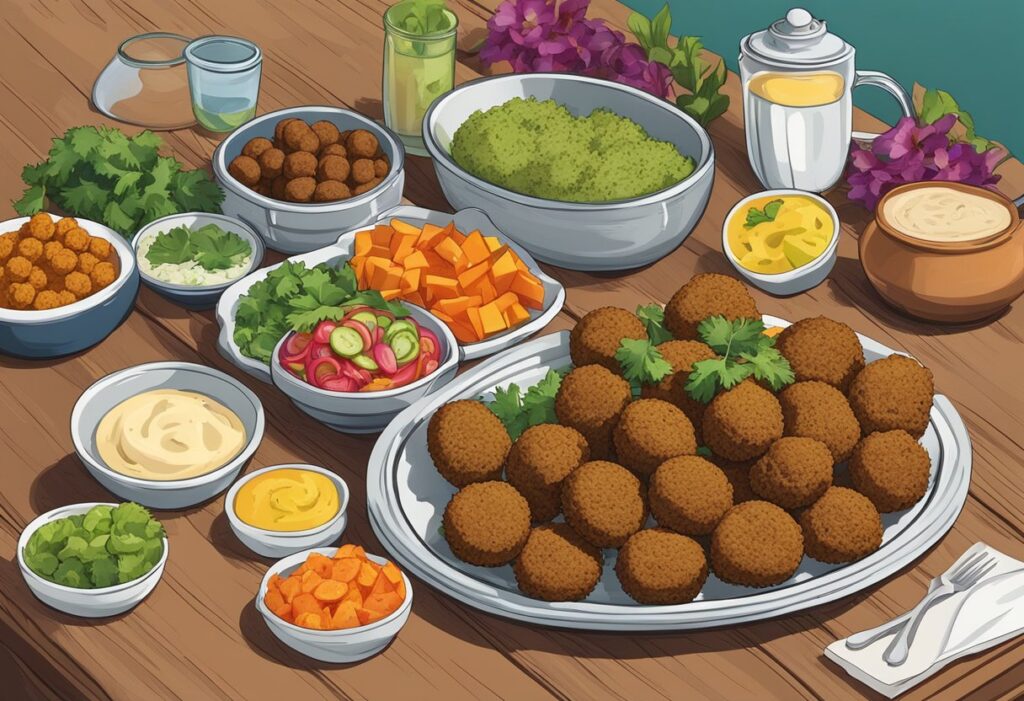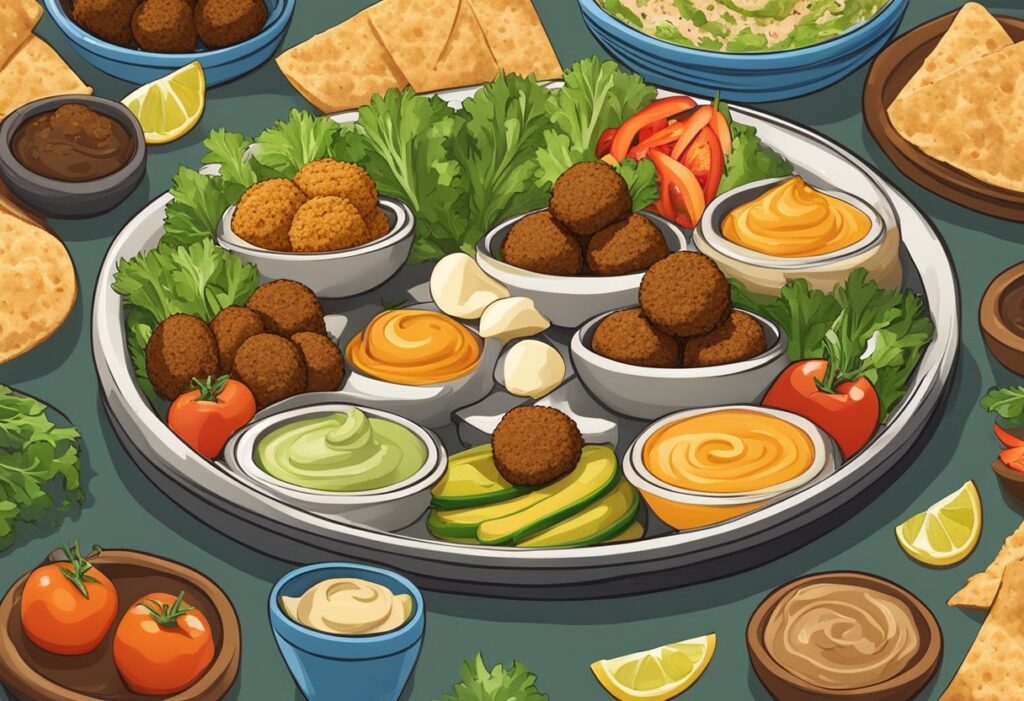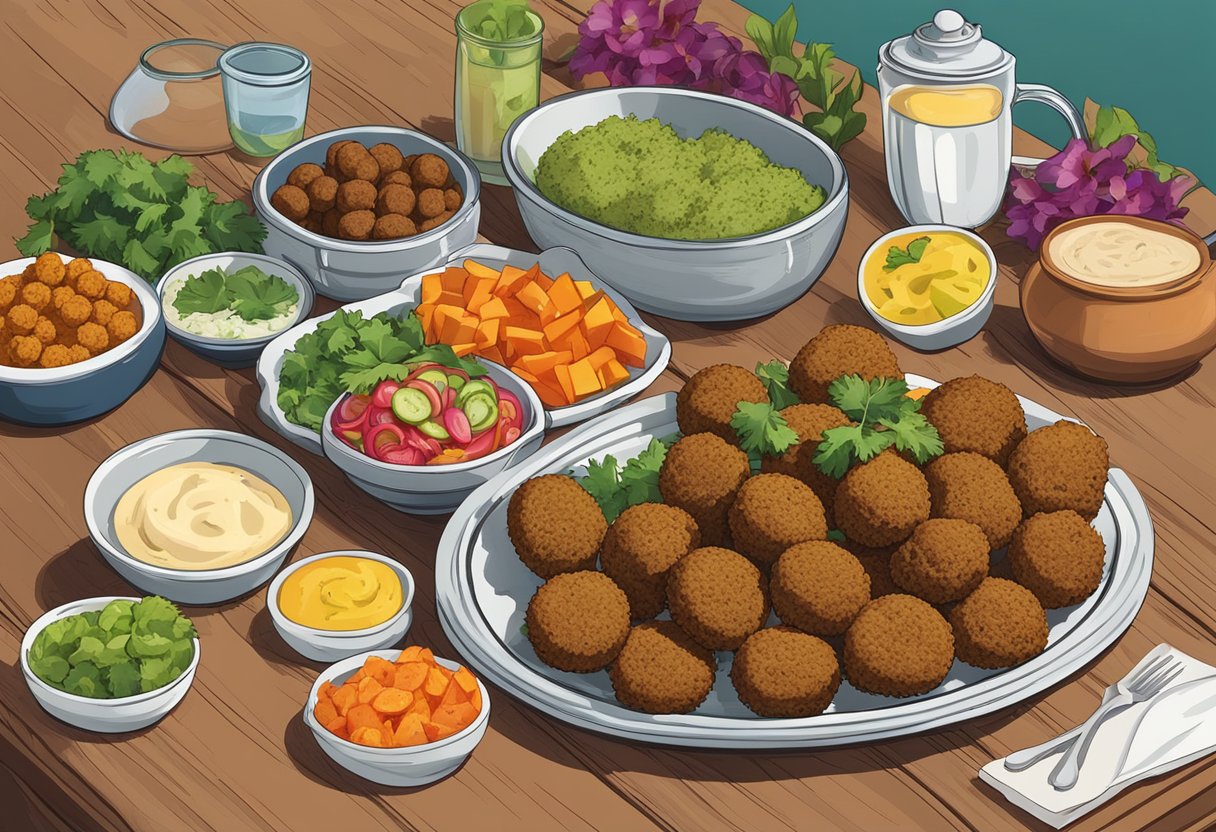Falafel is a popular Middle Eastern dish that has gained popularity all over the world. The dish is made from ground chickpeas, fava beans, or a combination of both, mixed with herbs and spices, and then deep-fried until crispy. It is often served in a pita bread with vegetables and sauces, but it can also be enjoyed as a platter with a variety of sides.
Table of Contents

Making a falafel platter at home is a great way to enjoy this delicious dish with a personal touch. The platter typically consists of falafel balls, hummus, tahini sauce, and a variety of salads and pickles. It is a healthy and filling meal that can be customized to suit any taste preference. In this article, we will share an easy and delicious falafel platter recipe that can be made in the comfort of your own kitchen.
History of Falafel

Origins
Falafel is a popular Middle Eastern dish made from ground chickpeas or fava beans. Its exact origin is unknown, but it is believed to have originated in Egypt over a thousand years ago. The dish was initially consumed by the Copts, an Egyptian Christian group, during Lent, when they were not allowed to eat meat.
Over time, falafel spread to other parts of the Middle East, including Lebanon, Syria, and Israel. In these countries, the dish was often served as street food and was consumed by people of all social classes.
Global Popularity
In the 20th century, falafel gained popularity around the world, particularly in Europe and North America. Today, it is a popular vegetarian and vegan option in many restaurants and fast-food chains.
Falafel is typically served as a sandwich, wrapped in pita bread with vegetables and sauces, or as a platter with side dishes such as hummus and tabbouleh. It is a nutritious and flavorful dish, rich in protein, fiber, and vitamins.
Overall, falafel has become a beloved dish worldwide, enjoyed by people of all cultures and backgrounds.
Essential Ingredients

Chickpeas
Chickpeas are the main ingredient in falafel. They are a great source of protein and fiber, making them a healthy addition to any diet. The chickpeas used in falafel platter recipe should be dried and soaked overnight to ensure they are cooked properly. It is important to drain the chickpeas well before using them in the recipe.
Herbs and Spices
Herbs and spices are what give falafel its unique flavor. The most commonly used herbs in falafel are parsley and cilantro. Other herbs such as mint and dill can also be used to add additional flavor. The spices used in falafel include cumin, coriander, and garlic. These spices are what give falafel its distinct aroma and taste.
Binding Agents
Binding agents are what hold the falafel mixture together. The most commonly used binding agent is flour. Chickpea flour is the preferred flour to use in falafel, but all-purpose flour can also be used. Baking powder is also added to the mixture to help the falafel rise and become fluffy. It is important to use the right amount of binding agents to ensure the falafel holds its shape and doesn’t fall apart while cooking.
In summary, the essential ingredients in falafel platter recipe are chickpeas, herbs and spices, and binding agents. These ingredients are what give falafel its unique flavor, texture, and aroma. By using the right amount of each ingredient, you can create a delicious and healthy falafel platter that is sure to impress.
Equipment Needed
To prepare a delicious falafel platter, certain equipment is necessary. Here are the essential tools required to make the perfect falafel platter:
Food Processor
A food processor is an essential tool in making falafel. It is used to grind the chickpeas, onions, and other ingredients into a fine paste. A food processor with a large capacity will make the process quick and easy.
Mixing Bowl
A mixing bowl is necessary to mix all the ingredients together. A large mixing bowl is recommended to ensure that all the ingredients are well combined.
Measuring Cups and Spoons
Measuring cups and spoons are essential to ensure that the ingredients are measured accurately. It is important to measure the ingredients precisely to ensure that the falafel is not too dry or too moist.
Frying Pan
A frying pan is necessary to fry the falafel balls until they are crispy and golden brown. A non-stick frying pan is recommended to ensure that the falafel does not stick to the pan.
Serving Platter
A serving platter is necessary to present the falafel platter. A large platter is recommended to accommodate all the falafel balls and the accompanying vegetables and dips.
By having all the necessary equipment, making a falafel platter can be a fun and easy process.
Falafel Platter Components
Falafel Balls
Falafel balls are the star of the falafel platter. Made from ground chickpeas, herbs, and spices, these crunchy and flavorful balls are the perfect protein-packed addition to any meal. The traditional recipe for falafel balls includes chickpeas, parsley, cilantro, onion, garlic, cumin, coriander, and salt. However, many variations of the recipe exist, including using fava beans instead of chickpeas or adding different herbs and spices for a unique taste.
Dips and Sauces
A falafel platter is not complete without a variety of dips and sauces. Tahini sauce, made from sesame paste, lemon juice, garlic, and water, is a classic accompaniment to falafel balls. Other popular dips include hummus, baba ghanoush, and tzatziki. These dips are not only delicious but also provide a cooling contrast to the spiciness of the falafel balls.
Salads and Pickles
Salads and pickles are essential components of a falafel platter. A simple salad of chopped tomatoes, cucumbers, and parsley can add freshness and crunch to the dish. Pickled vegetables, such as turnips, beets, and cabbage, provide a tangy and slightly sour flavor that complements the falafel balls.
Bread and Wraps
Finally, a falafel platter is typically served with bread or wraps. Pita bread is the most common choice, but other options include lavash or naan. Wraps made from lettuce leaves or collard greens are also a healthy and gluten-free alternative. The bread or wrap is used to encase the falafel balls and other components, creating a delicious and satisfying meal.
Preparing the Falafel Mix
Soaking Chickpeas
Before starting the falafel mix, it is necessary to soak the chickpeas in water overnight or for at least 12 hours. This process helps to soften the chickpeas and make them easier to blend. Once the chickpeas are soaked, they should be drained and rinsed thoroughly.
Blending Ingredients
To prepare the falafel mix, the soaked chickpeas are blended with a variety of ingredients. These typically include garlic, onion, parsley, cilantro, cumin, coriander, salt, and pepper. It is important to blend the ingredients thoroughly until a smooth and consistent texture is achieved.
Some recipes may call for additional ingredients such as flour or baking powder to help bind the falafel mix together. It is important to follow the recipe closely and adjust the ingredients as necessary to achieve the desired consistency.
Overall, preparing the falafel mix requires some patience and attention to detail, but the end result is a delicious and nutritious dish that can be enjoyed by all.
Shaping and Cooking Falafel
Forming Balls or Patties
Shaping falafel is an important step in the cooking process. Traditionally, falafel balls are formed by hand, but some people prefer to make patties instead. To form falafel balls, take a small amount of the mixture and roll it between your palms until it forms a ball. To make patties, shape the mixture into small discs using your hands or a falafel scoop.
It’s important to note that the size of the balls or patties can affect the cooking time. Smaller balls or patties will cook faster than larger ones. Additionally, if the balls or patties are not shaped evenly, they may not cook evenly.
Frying Techniques
Frying falafel is the most common cooking method. To fry falafel, heat oil in a deep pot or fryer to 350°F. Carefully drop the balls or patties into the hot oil and cook until they are golden brown, about 3-5 minutes. Remove from the oil with a slotted spoon and place on a paper towel to drain excess oil.
Some people prefer to bake falafel instead of frying it. To bake falafel, preheat the oven to 375°F and place the balls or patties on a baking sheet lined with parchment paper. Brush the falafel with oil and bake for 20-25 minutes, flipping halfway through.
No matter which cooking method you choose, it’s important to make sure the falafel is cooked all the way through. Raw falafel can be dangerous to consume. To check if the falafel is cooked, cut one open and make sure it’s not raw in the middle.
Assembling the Platter
Arranging Components
When it comes to assembling the falafel platter, there are a few key components that need to be arranged in an aesthetically pleasing and practical manner. First, start with a bed of fresh lettuce leaves or other greens of your choice. Then, arrange the falafel patties in a circular pattern on top of the greens.
Next, add the hummus, tzatziki, and tahini sauces to the platter. It’s best to place them in small bowls or ramekins to keep them separate from the other components. This not only makes it easier for guests to dip and enjoy each sauce, but also prevents the sauces from mixing together and creating a mess on the platter.
After the sauces, add the sliced tomatoes, cucumbers, and pickled vegetables to the platter. These components not only add color and texture to the platter, but also provide a refreshing contrast to the rich and savory falafel patties.
Finally, top the platter with a sprinkle of chopped parsley or cilantro for a pop of fresh herb flavor and a touch of green.
Garnishing Tips
To take your falafel platter to the next level, consider adding a few extra garnishes. A sprinkle of sumac or za’atar seasoning on top of the hummus or falafel patties adds a burst of Middle Eastern flavor.
For a touch of sweetness, add a drizzle of pomegranate molasses or honey over the platter. This not only adds a delicious flavor, but also creates a beautiful presentation with its deep red color.
Don’t forget to serve the falafel platter with warm pita bread or other flatbreads for a complete and satisfying meal.
Serving Suggestions
When serving a falafel platter, there are a few key components that can elevate the dish and make it even more delicious. Here are some serving suggestions to consider:
1. Pita Bread
Pita bread is a staple when it comes to serving falafel. It’s a great vehicle for the falafel balls and can be used to make a sandwich or wrap. Warm the pita bread up in the oven or on a skillet before serving for added flavor.
2. Hummus
Hummus is a classic dip that pairs perfectly with falafel. It can be used as a spread on the pita bread or as a dip for the falafel balls. Consider making your own hummus from scratch for a fresher and more flavorful option.
3. Tahini Sauce
Tahini sauce is another popular condiment for falafel. It’s a creamy sauce made from sesame seeds that adds a nutty flavor to the dish. Drizzle it over the falafel balls or use it as a dip for the pita bread.
4. Pickled Vegetables
Pickled vegetables, such as cucumbers, carrots, and radishes, add a tangy and refreshing element to the dish. They can be served on the side or used as a topping for the falafel balls.
5. Salad
A simple salad can help balance out the richness of the falafel platter. Consider serving a salad with fresh greens, tomatoes, and cucumbers. Dress it with a lemon vinaigrette for a bright and zesty flavor.
By incorporating these serving suggestions, you can take your falafel platter to the next level and create a delicious and satisfying meal.
Storage and Reheating Instructions
Once the falafel platter is prepared, it can be stored in the refrigerator for up to 3 days. It is important to store the falafel separately from the other components of the platter to prevent the vegetables from getting soggy.
To reheat the falafel, preheat the oven to 350°F and place the falafel on a baking sheet. Bake for 10-12 minutes or until heated through. Alternatively, the falafel can be reheated in the microwave for 30-45 seconds, but this may result in a less crispy texture.
The pita bread can be stored at room temperature in an airtight container for up to 3 days. To reheat, wrap the pita bread in foil and place in a preheated 350°F oven for 5-7 minutes.
The hummus and tzatziki can be stored in airtight containers in the refrigerator for up to 5 days. Before serving, stir well and add a drizzle of olive oil to refresh the flavors.
Overall, following these storage and reheating instructions will help ensure that the falafel platter remains fresh and flavorful for optimal enjoyment.

